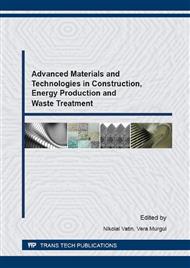p.166
p.173
p.185
p.192
p.199
p.208
p.216
p.223
p.233
Comparative Effect of Different Coagulants on Physical Properties of Drill Cuttings
Abstract:
The paper presents the study on the physical properties of the cuttings. Culvert capacity of the drill cuttings with different coagulants is considered. The water permeability of the studied samples varies depending on the quality of the composition and the dosage of a coagulant used. The coagulants have been proposed as aluminium sulphate, iron sulphate, calcium chloride, gypsum, phosphogypsum, serpentine, blast furnace slag, calcium carbonate and carnallite. Iron and aluminium sulphates, calcium chloride, gypsum and phosphogypsum appear to be the most effective when acting on the water permeability in the drill cuttings. With regard to the variants incorporating the complete response curve, the optimal dose of ameliorant can be determined after maximum filtration of water in the column. This method allows the dose of coagulant to be determined by the filtration threshold. The optimal dose for iron sulphate is 0.8 g; with this parameter the volume of filtered water reaches 16.80 ml / day.The use of effective coagulants allows displacement of sodium and potassium cations from the absorption complex and fundamentally improves its physical and chemical properties; this is clearly seen by the change of the filtration capacity of the considered sample. Phosphogypsum – a waste material of chemical industry of Ural chemical plants - is of the greatest interest. It can significantly improve the properties of the considered sample when transforming two waste materials (drill cuttings and phosphogypsum) to a neutral environmentally-friendly state.
Info:
Periodical:
Pages:
233-241
Citation:
Online since:
September 2016
Price:
Сopyright:
© 2016 Trans Tech Publications Ltd. All Rights Reserved
Share:
Citation:


